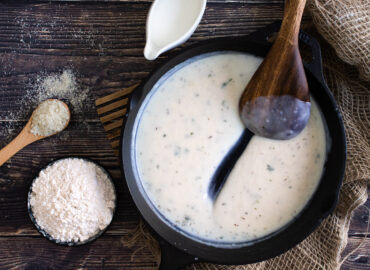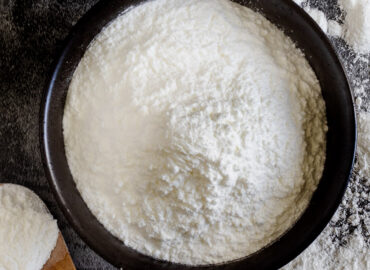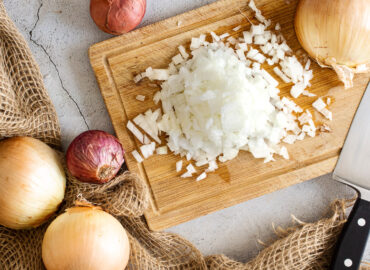*This post may contain affiliate links. Read my disclaimer here. While we may use affiliate links, we would never allow this to influence product listings or recommendations.
Bicarbonate of soda… baking soda… what are all these powdery substances anyway and when exactly should you use bicarbonate of soda vs baking soda? Well, the long and short of it is that:
Bicarbonate of soda and baking soda are the exact same thing. And if you see the name sodium bicarbonate, that’s the same too!
In the US you are more likely to see it go by the name baking soda, while in the UK and Australia the name bicarbonate of soda is typically used. In Europe, you may also see the name Natron. To make things even more confusing, there are a whole host of other names and abbreviations you may see such as:
- Bicarb (or sodium bicarb)
- Bicarb soda
- Bicarbonate
- Bread soda
- Cooking soda
One thing that it is not is baking powder, so don’t get those mixed up (you can read more about the differences between baking soda and baking powder here).
Still scratching your head wondering what the heck this powdery stuff is? Read on for some more information about what bicarbonate of soda is and what it is typically used for:
What is bicarbonate of soda?
Bicarbonate of soda is a chemical compound. It is an alkaline substance that is most commonly used in baking as a leavening ingredient. This means that it helps your baking rise, making it fluffy and delicate, instead of dense and flat.
You’ll actually find bicarbonate of soda in a lot of other standard household things such as toothpaste and deodorant. You can read more about its other uses below.

How do I use bicarbonate of soda in baking or cooking?
Bicarb needs to be activated with an acid in order to work. The acid used can take many forms, such as:
- Lemon juice
- Yogurt
- Brown sugar
- Sour cream
- Honey
- Cocoa powder
- Fruit or fruit juice
It is a potent substance and when exposed to heat it releases carbon dioxide which makes the food rise (leaven). The escaped carbon dioxide leaves gaps in the texture of the baked goods, giving that unique airy and fluffy consistency.
When you are using a recipe with bicarbonate of soda make sure to use only the amount specified, as too much can make foods taste metallic.
You can also use bicarbonate of soda to tenderise meat, in a process known as velveting. This is particularly useful for stir fry recipes (such as this fakeaway chicken chow mein). Simply add a teaspoon of soda for every 500g / 1 lb of meat and mix together. Leave for 15 minutes before rinsing off the soda and cooking the meat.
What ratio of soda to acid should I use?
This is where the science comes in:
- You should use enough baking soda to lift the flour in the recipe. This is around 1/4 teaspoon for 120g or 1 cup of flour
- You should use the right amount of acid which will be neutralised by the soda. For 1/4 teaspoon of soda this is around 125ml or 1/2 cup of acid.
So, if you had a recipe that called for 240g of flour you would need 1/2 teaspoon of baking soda and 250ml / 1 cup of acid ingredient.
However, you can also substitute some of the bicarbonate of soda with baking powder if it doesn’t make sense to use that much acid ingredient. When using baking powder you will need 4 x the amount of bicarb, as it isn’t as potent.
You can read more about bicarbonate of soda vs baking powder here.
How can I check it is fresh?
Bicarbonate of soda can go ‘off’ over time, meaning that it will lose its potency and therefore its effectiveness. It is recommended to check how fresh your soda is to make sure that your baking gives you the best results.
To test simply add a teaspoon of soda to a small bowl. Pour over a tablespoon of vinegar and watch the reaction. If the soda vigorously bubbles up then it’s fresh. If the bubbles are lacklustre then it’s probably on its way out and you should buy some more as the reaction in your food will also be reduced. Finally, if there is no reaction or bubbles at all then it’s completely past being usable.
Is bicarbonate of soda bad for you?
Bicarbonate is naturally produced in the body and helps regulate our chemical balance. An example of this is if you go for a run, your muscles will produce lactic acid (this is what can lead to painful sore muscles). Your body will produce alkaline bicarbonate to offset this acid build-up. Consuming a small amount in food is in no way harmful.
However, consuming too much bicarbonate of soda can have some negative side effects. You might develop a headache or feel sick. It can also lead to a rise in blood pressure. While it is commonly used as a cure for acid reflux, this should be done with caution as it can affect the natural digestion system since our stomachs are naturally very acidic and ingesting the alkaline soda can throw the PH levels in the body off.
What else can I use it for?
Bicarbonate of soda can be used for a lot more than just cooking. Here are a few other uses for that packet of powder in the cupboard:
- As an alternative to talc. Baking soda has natural properties which will kill the bacteria found in sweat, which is why it is so commonly used in deodorant. You can also sprinkle it on your feet or other areas that are prone to sweat and odors.
- To clean those grubby trainers/sneakers. Mix 1 part bicarbonate of soda with 1 part water until you have a paste and then use a scrubbing brush or old toothpaste to scrub your shoes. Let it dry for 30 minutes and then clean any excess with water and a sponge. Repeat until your shoes are sparkling white again. This will also work on clothes.
- To remove odors from your shoes. Sprinkle bicarbonate of soda into each shoe and shake to distribute evenly. You’ll need enough to cover the sole – around 2 tbsp per shoe. Leave it for 24 hours and then tip out the soda (don’t worry if there is still some stuck to the inside, it won’t cause any harm!)
- To reduce nasty fridge smells. As bicarbonate of soda kills the bacteria which can be responsible for certain odors, it actually neutralises the smell rather than masking it. Leave a cup of baking soda in the back of the fridge to help.
Now you’ve learnt all about what bicarbonate of soda is, and how to use it, why not try out your new knowledge in one of these recipes:









